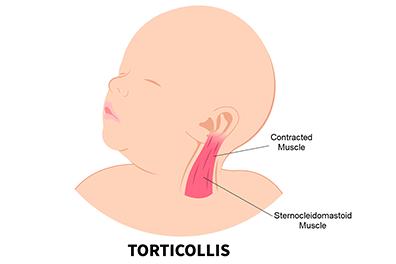At Children's Health℠, we see more children with congenital and acquired torticollis (tor·ti·col·lis) than almost any other hospital in our region. Our team includes world-class doctors and physical therapists who specialize in treating children with torticollis and many other conditions. This gives us the experience and expertise to help your child overcome this condition and go on to a happy, healthy childhood.
Overview
What is pediatric torticollis?

Congenital torticollis or infant torticollis is a condition that develops when a baby’s neck muscle (sternocleidomastoid) is short and tight.
This issue causes a baby’s head to tilt to one side and limits their range of motion.
The condition is usually present at birth (congenital) and is sometimes called twisted neck or wryneck.
Acquired torticollis is a condition that develops after a baby is born.
Types
What are the different types of pediatric torticollis?
The two main types of infant torticollis are:
Congenital torticollis, also known as congenital muscular torticollis (CMT), exists at birth. It’s the most common type of pediatric torticollis.
Acquired torticollis is a condition that develops after a baby is born.
Signs and Symptoms
What are the signs and symptoms of pediatric torticollis?
Congenital torticollis
Head tilting, favoring one side
Movement of the head to one side more than the other
Small bump in the middle of the neck muscle
Preference to look one way more than the other
Preference of resting their head on one side rather than the other when feeding or eating
Unusual head shape or a flat spot on the head (plagiocephaly)
Acquired torticollis
Head always tilted to one side
Temporary spells of head tilting, lasting a few hours or days, that can also cause vomiting
Bulge in your child’s neck
Limited range of motion in the head and neck
Vision problems
Diagnosis
How is pediatric torticollis diagnosed?
Our doctors diagnose pediatric torticollis with a physical examination. During the exam, we’ll discuss your baby’s medical history, check their head shape and test how they move their neck. Sometimes, we recommend X-rays and vision exams to help confirm a diagnosis.
Although congenital torticollis occurs at birth, it may go unnoticed for several weeks. On average, most babies with congenital torticollis are diagnosed within the first few months of life.
Acquired torticollis typically develops in the first four to six months of a child’s life but can occur later.
Causes
What causes pediatric torticollis?
The cause of pediatric torticollis depends on the type.
Congenital torticollis results from the shortening or tightening of the neck muscle, which can happen because of:
The way the baby was positioned in the womb during pregnancy
Unusual development of the neck muscle
Injury during birth
Acquired torticollis usually results from an injury (trauma) or underlying health condition, such as:
Mild infection
Head or neck injury
Sandifer syndrome (movement disorder)
Klippel-Feil syndrome or other conditions that affect the bones of the neck (cervical spine)
Treatment
How is pediatric torticollis treated?
At Children's Health, we offer care from a team of experts who have special training in helping children overcome torticollis and many other conditions. Our doctors and physical therapists (PT) will pinpoint what's causing your child's torticollis. Then we'll build a custom treatment plan just for them.
Treatment for congenital torticollis typically begins with physical therapy (PT) to stretch and strengthen the neck. Most babies improve their head and neck movement after a few months of PT. We will also show you ways to support your child’s recovery at home, with tummy time and stretching routines.
Treatment for acquired torticollis aims at addressing the underlying cause to improve movement and symptoms.
Your child’s care plan may include:
Medication to relieve pain and other symptoms
Physical medicine and rehabilitation (PM&R), including PT
Orthopedic surgery, neurosurgery or plastic surgery, in rare cases, to lengthen the neck muscle
The children we see with torticollis almost always completely recover. If torticollis affects the shape of your baby’s head, we fit babies for safety helmets at our specialty clinic.
What are the long-term effects of pediatric torticollis?
Care and treatment from the right physical therapist can help children overcome torticollis.
If the condition doesn’t improve, it can cause long-term effects such as:
Permanent muscle tightening
Unusual appearance in facial features (asymmetry)
Flat spot on one side or back of the head (plagiocephaly)
Motor development problems
Eye alignment problems that can lead to crossed eyes (strabismus)
Difficulty with balance
Does infant torticollis go away?
Our care team recommends treatment for torticollis to prevent long-term complications. With proper care, children with torticollis usually fully recover.
Does pediatric torticollis cause developmental delays?
Infant torticollis can delay important physical milestones, such as rolling over, sitting upright, crawling, standing and walking. Torticollis can also affect the quality of movement, making it harder for a baby to sit up, crawl or walk.
Doctors and Providers
At Children’s Health, our pediatric team includes experts in plastic surgery, orthopedics, physical medicine and rehabilitation, neurosurgery and physical therapy. Together, our specialists identify the cause of torticollis and create a care plan that’s customized to your child’s needs.
 Alex A KanePlastic and Craniofacial Surgeon
Alex A KanePlastic and Craniofacial Surgeon James Richard SeawardPlastic and Craniofacial Surgeon
James Richard SeawardPlastic and Craniofacial Surgeon Jessica Ruth GrantPhysician Assistant - Plastic Surgery
Jessica Ruth GrantPhysician Assistant - Plastic Surgery Laura Christine HannaPhysician Assistant - Plastic Surgery
Laura Christine HannaPhysician Assistant - Plastic Surgery Kimly Dinh NguyenPhysician Assistant - Plastic Surgery
Kimly Dinh NguyenPhysician Assistant - Plastic Surgery Riley PowersPhysician Assistant - Plastic Surgery
Riley PowersPhysician Assistant - Plastic Surgery Sarah Elizabeth WigginsPhysician Assistant - Plastic Surgery
Sarah Elizabeth WigginsPhysician Assistant - Plastic Surgery Elizabeth Loveless WetzPhysician Assistant - Plastic Surgery
Elizabeth Loveless WetzPhysician Assistant - Plastic Surgery